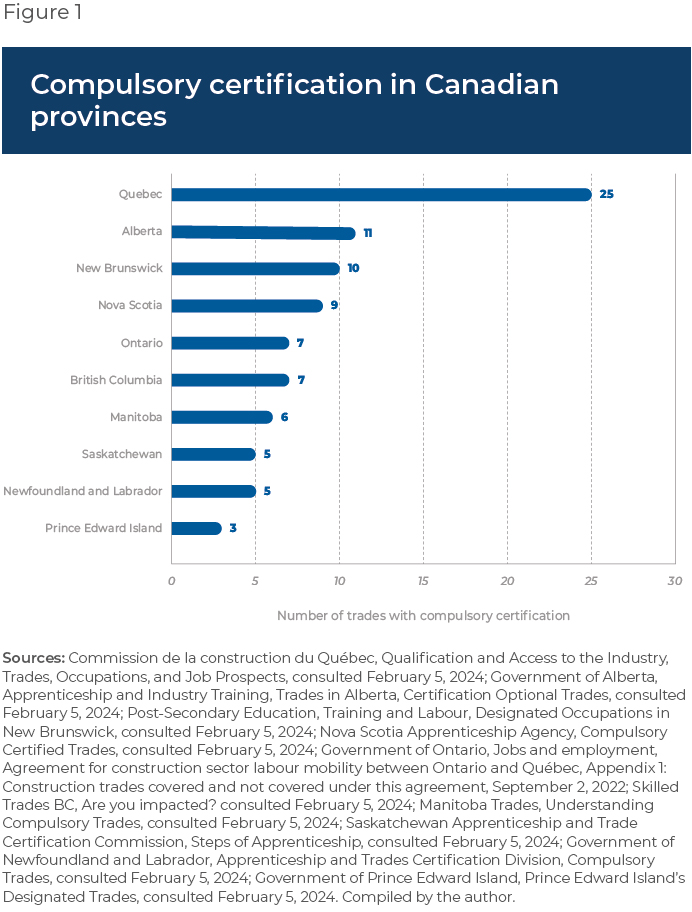Decompartmentalizing Construction Trades: How Much Is Enough?

Viewpoint proposing that Quebec abolish compulsory certification for many trades, with the goal of at least bridging the gap with the neighbouring province of Ontario
 Related Content
Related Content
 |
 |
 |
| Les cloisons doivent tomber dans le secteur de la construction (La Presse+, April 8, 2024)
Premier Legault, tear down these construction-industry walls (Financial Post, April 9, 2024) |
Interview (in French) with Gabriel Giguère (Boréale 138, ICI Radio-Canada, March 28, 2024)
Interview (in French) with Gabriel Giguère (Mario Dumont, QUB Radio, March 28, 2024) Interview (in French) with Gabriel Giguère (Richard Martineau, QUB Radio, April 9, 2024) |
This Viewpoint was prepared by Gabriel Giguère, Public Policy Analyst at the MEI. The MEI’s Regulation Series aims to examine the often unintended consequences for individuals and businesses of various laws and rules, in contrast with their stated goals.
It is no secret that Quebec’s construction sector needs to become more productive. To address this issue, Labour Minister Jean Boulet has tabled Bill 51, entitled An Act to modernize the construction industry,(1) which aims to allow construction workers to be more versatile. The proposed modifications, however, do not go far enough. A more promising route would be the removal of compulsory certification for most trades.
The regulatory framework for the construction sector, which has been in place for several decades, requires compulsory certification to practise one of 25 construction trades in Quebec.(2) Carpenter-joiners, for instance, can only carry out those tasks the government considers they are able to accomplish, even if they have the skills and the know-how to carry out other related tasks.(3) They therefore cannot paint walls, a task reserved to house painters, or carry out other tasks that are not included in the official definition of their trade.(4)
The strict regulation of trades by the Commission de la construction du Québec(5) reduces the flexibility of all construction workers and exposes worksites to delays, notably when professionals of one of the trades are not readily available to perform a task. A study conducted for the Association de la construction du Québec shows that greater flexibility would have a positive impact on the productivity of labour.(6) Such a productivity gain, whatever its magnitude, would reduce the number of hours required for work to be completed on a worksite, which would therefore reduce costs.
A less rigid approach allowing building contractors to freely choose workers based on their actual skills, not their certification, would be broadly beneficial, with no adverse effects on health or safety.(7) This more flexible regulatory approach would reduce costs related to the unavailability of labour, as well as general operating costs.
More Flexibility Elsewhere in Canada
Quebec is not the only province that requires certification to practise certain construction trades. However, it is the only province where over twenty trades are subject to this requirement (see Figure 1). Coming in a distant second is Alberta, with fewer than half as many trades with compulsory certification. As for the other more populous provinces, the contrast is even more striking: Ontario has only seven trades with mandatory certification, as does British Columbia.

Indeed, there are thirteen trades for which Quebec is the only Canadian province to impose certification (see the Annex). Most of these trades can be learned by acquiring experience on the ground, without requiring any explicit training, but the regulatory framework is very rigid in this regard.
In Ontario, training is offered for the trades of general carpenter and painter, but is not compulsory.(8) This approach, if it were adopted in Quebec, would allow workers to continue to specialize in one particular area. At the same time, it would give contractors more flexibility, as they could choose workers based on their actual skills, whether certified by official training or simply acquired through on-the-job apprenticeship, without having to abide by a long list of criteria pre-established by the government in order to judge the validity of such on-the-job experience, as is currently the case.(9)
A More Ambitious Legislative Change Is Needed
The bill tabled by the government allows for the possibility of journeyman workers carrying out tasks other than their own, as defined by the government, only if:
- these tasks are related to those stipulated in the definition of their trade;
- they are part of a single sequence of work and allow for the advancement as well as the continuity of the work, including preparation and finishing;
- they are short-term and carried out over the course of a single workday.(10)
The purpose of these measures is to increase the versatility of workers, but they do not go far enough in decompartmentalizing the construction sector.
The government should be more ambitious and aim for the removal of as many compulsory certifications as possible. A first step would be to abolish compulsory certification for all trades for which certification is compulsory only in Quebec, which would eliminate over half of them. The government could then examine the twelve remaining trades on a case-by-case basis, with the goal of at least bridging the gap with Ontario.
In the midst of a housing shortage in Quebec, we must not be content with half-measures when it comes to allowing greater worker versatility in the construction sector.
* * *
Annex: Construction Trades for which Certification Is Compulsory Only in Quebec
- Insulator: installs thermal insulation and piping systems insulation
- Tile setter: prepares surfaces, cuts and lays ceramic tiles and other similar materials
- Carpenter-joiner: erects frames for walls, floors, roofs, etc.
- Cement finisher: prepares, installs, and repairs cement
- Roofer: installs roof coverings
- Reinforcing steel erector: installs rods, wire mesh, and any other material to reinforce concrete
- Millwright: installs, repairs, adjusts, assembles, and disassembles machinery
- Erector mechanic (glazier): installs and repairs glass products and all similar items
- Shovel operator: operates all types of mechanical shovels, backhoes, etc.
- Painter: prepares and conditions construction surfaces, including their covering
- Plasterer: points joints and covers or levels surfaces using specialized tools
- Resilient flooring layer: lays resilient vinyl flooring, etc.
- Interior systems installer: erects walls, partitions, and ceilings, etc.
Note: For complete definitions of construction trades, see: Commission de la Construction du Québec, Qualification and Access to the Industry, Trades, Occupations, and Job Prospects. Compiled by the author.
References
- National Assembly of Québec, Bill 51 – An Act to modernize the construction industry, section 72, January 31, 2024; Geneviève Lajoie, “Révolution en construction: plus besoin de 7 métiers pour changer une porte,” Le Journal de Québec, September 30, 2023.
- Commission de la construction du Québec, Qualification and Access to the Industry, Trades, Occupations, and Job Prospects, consulted February 2, 2024.
- For the list of task definitions for each trade, see: Government of Quebec, Regulation respecting the vocational training of the workforce in the construction industry, Chapter R-20, r. 8, Schedule A, December 12, 2023.
- Certain exceptions are stipulated in the regulatory framework. Commission de la construction du Québec, Application of Act R-20, Application of Act R-20, Exclusions, consulted February 5, 2024.
- Government of Quebec, Act Respecting Labour Relations, Vocational Training and Workforce Management in the Construction Industry, section 123.1, January 1st, 2024.
- Philippe Gougeon et al., Productivité dans le secteur de la construction et impact d’accroître la polyvalence des métiers, APPECO, Submitted to Francine Sabourin, Executive Director, Association de la construction du Québec, August 30, 2023, p. 4. The study elicited certain criticisms, which did not question the productivity gains related to greater worker flexibility, but rather the magnitude of these productivity gains, which was 10% in the APPECO study. Francis Halin, “Deux fois moins long pour changer des cadres de portes: ‘Les hôpitaux et les écoles pourront être construits plus vite’,” Le Journal de Montréal, January 31, 2024.
- According to the Association of Workers’ Compensation Boards of Canada, the data do not show that there are fewer accidents at work in Quebec, proportionally speaking. Association of Workers’ Compensation Boards of Canada, National Work Injury, Disease and Fatality Statistics (NWISP) – Year at a Glance, consulted February 14, 2024.
- Skilled Trades Ontario, Trades information, consulted February 5, 2024.
- Regulation in Quebec stipulates that it is not possible for an individual to obtain certification through experience, unless there is a lack of workers of a specific trade in a given region, measured as a percentage of workers in the workforce. This avenue is complex and requires a labour shortage for untrained individuals to be able to work under the supervision of a journeyman.
- National Assembly of Québec, op. cit., endnote 1.

